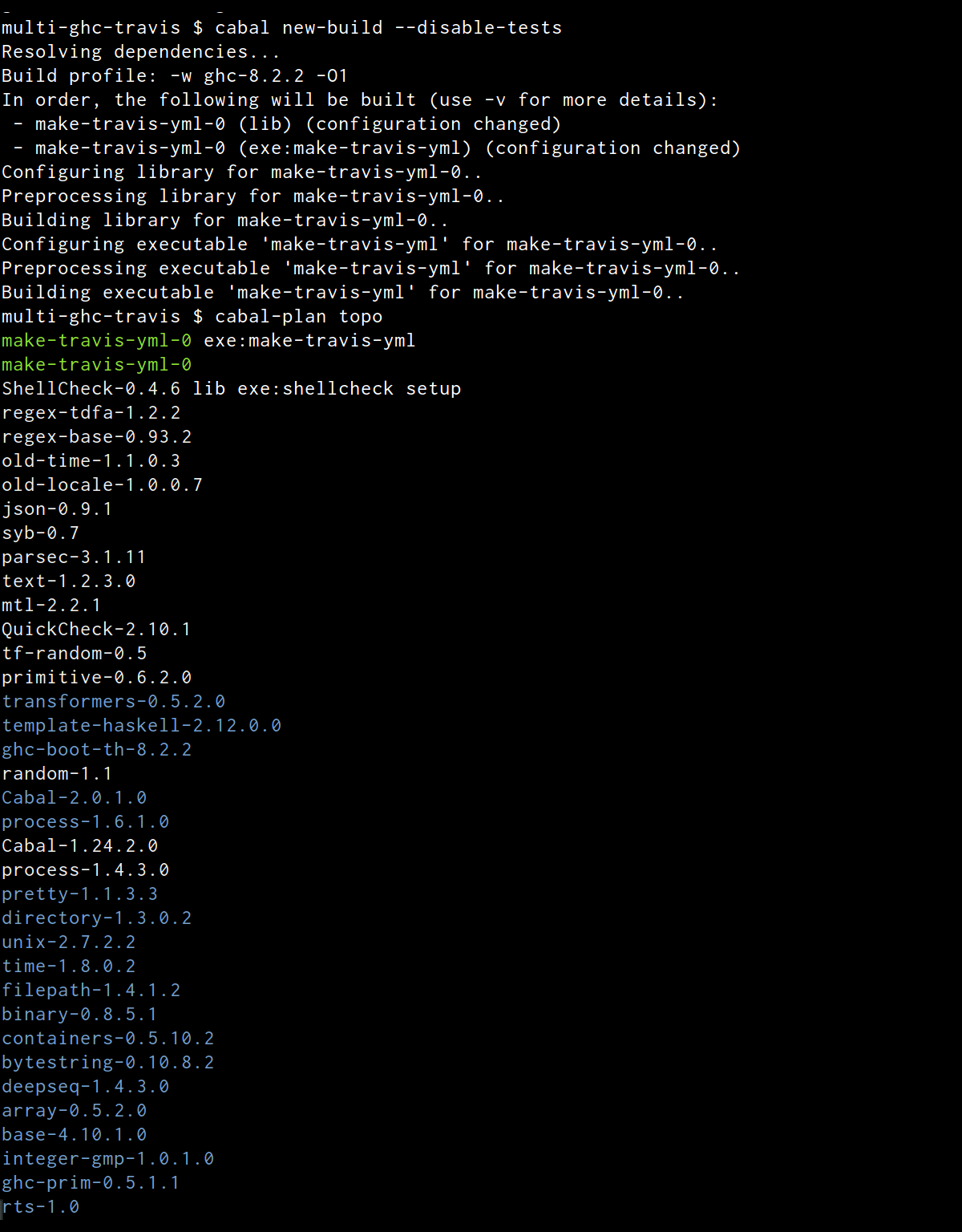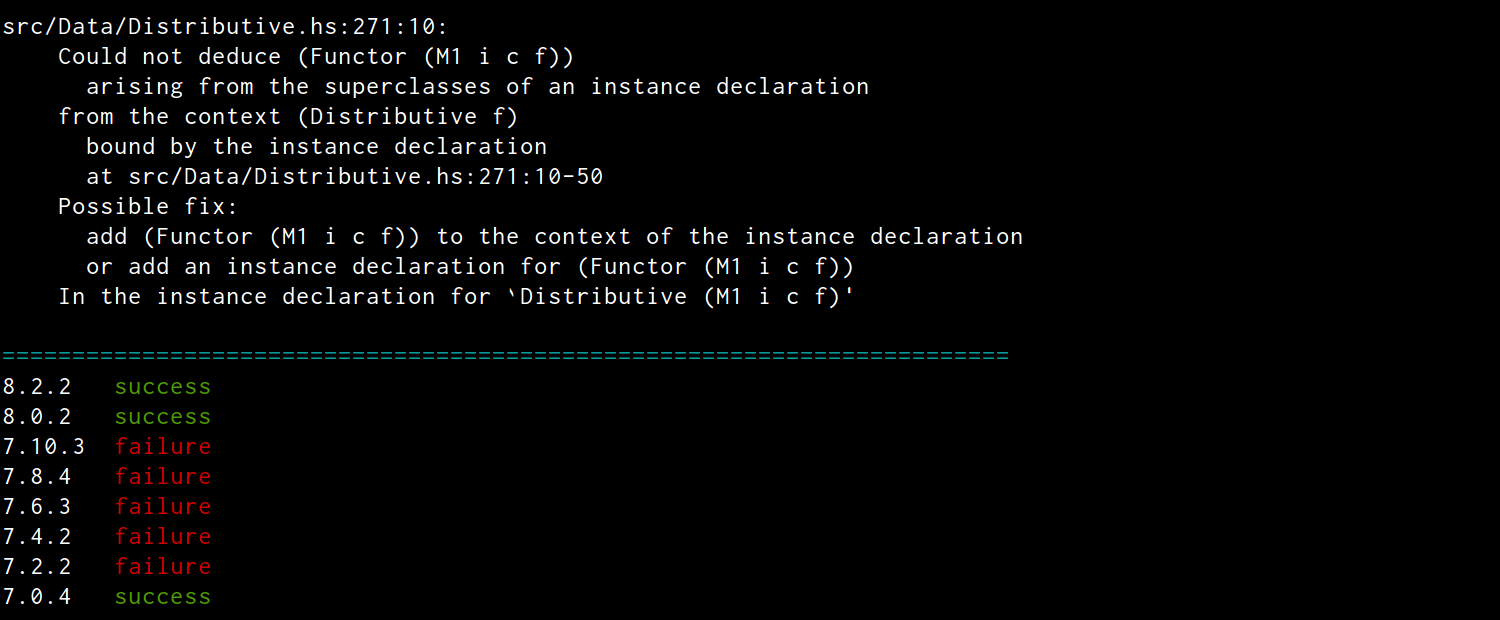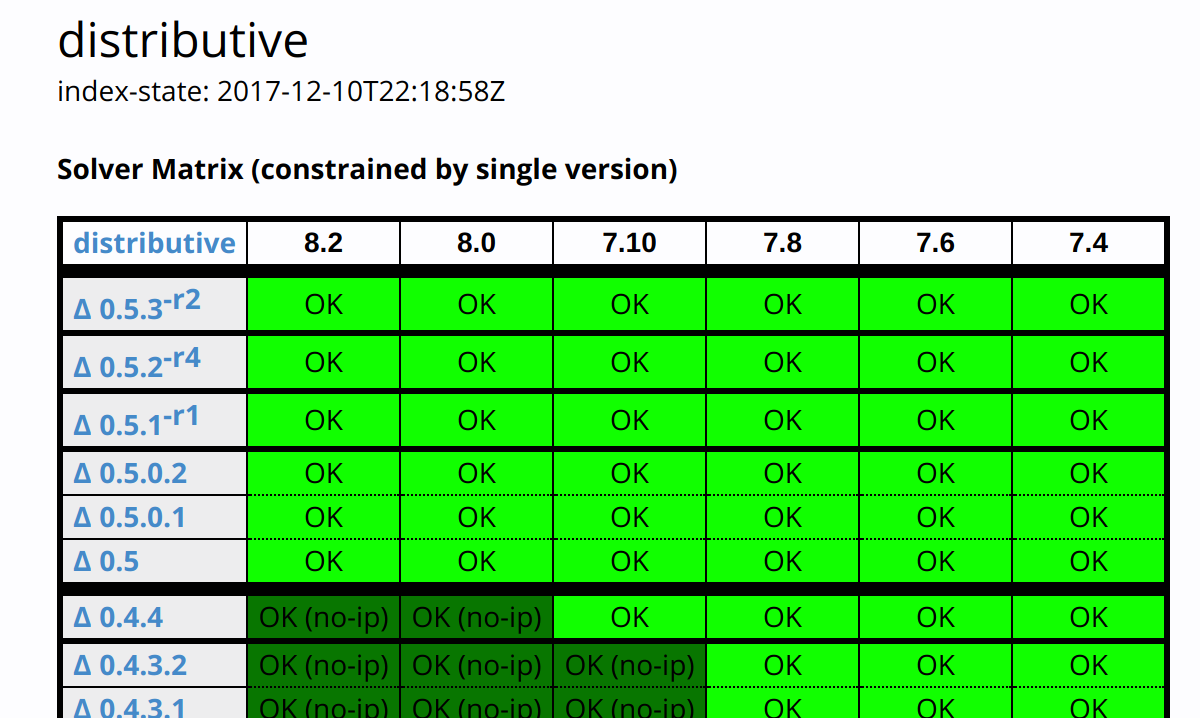New things in Haskell package QA
During the last month I have been working (not alone) on few Haskell package QA related tools:
In this posts I'll show what's new!

## cabal-plan
cabal-plan is a library and utility for processing cabal's new-build plan.json file. Yesterday the 0.3.0.0 version was released, with cool (because I did them) additions to the executable part.
Note: these features are something which would be nice to have in cabal-install proper eventually. For now it's easier to hack on them externally, though.
#list-bin completer
The list-bin / list-bins completer is smart:
cabal-plan list-bin ca<TAB>completes to
cabal-plan list-bin cabal-planThe command is useful to find the location of locally built executables. I did the completer work to to experiment with optparse-applicative's Completer interface.
Note: to make it even better we need to modify optparse-applicative to give already recognized options as the input to the completer. With custom --builddir option, completer doesn't work, as it looks for plan.json in the wrong place.
To enable completion in Bash add
eval "$(cabal-plan --bash-completion-script $(which cabal-plan))"somewhere into your .bashrc.
If you use Zsh, it's a little more complicated in general (you have to decide a path where to put completion functions); but if you use oh-my-zsh it's "decided" for you:
cabal-plan --zsh-completion-script $(which cabal-plan) > $HOME/.oh-my-zsh/completions/_cabal-planNote this works for all executables using optparse-applicative, e.g. trustee too.
#new command: topo
This command prints the topographic sort of the dependency graph.

In the example above, I build multi-ghc-travis with tests disabled. Otherwise the script (green components) depends only on boot libraries (blue), but when built as a package it uses ShellCheck to make self-tests when generating the .travis.yml commands.
Note: ShellCheck has custom setup, and without custom-setup section the implicit setup-depends bounds are used (in short: Cabal < 2).
#changes to dot command
In 0.3.0.0 the dot command was reworked to output a component graph. This is very useful, as you can differentiate between library and test dependencies.
To help see the difference, one small, but very visible change was made: The graph is colorful, different types of local components (library, executable, test-suite, etc...) and outbound edges have different colors.
Also Herbert nerd-snipped me to make a transitive-reduction "information preservation". Without the reduction, the graph is often very messy, so you pipe the dot info through dot. That however loses a bit of information. Therefore I taught cabal-plan --tred and --tred-weights options. Latter ones merges reduced paths into ones left, making them thicker. For example a part of servant dependency graph:
Shows that many things depending on wai-extra depend on its dependencies too. The bold arrow going down on the bottom right of the picture is heading to text.
In the same picture you see the --path-from wai-extra --path-to network highlight. That's useful to find a right part of the graph.
## multi-ghc-travis
The multi-ghc-travis is a repository with make-travis-yml script to generate Travis-CI's .travis.yml with multiple GHC configurations.
It uses cabal-install-head and various GHC versions in HVR's PPA.
Lately there was a lot of changes.
Now you can now use a config file, so you don't need to supply all options as command line arguments. I hope that will be useful for maintainers of multiple packages, as the config can be shared between different packages.
Note: everything (except constraint-sets) has command-line argument too, see --help output.
Second major addition is support of head.hackage overlay package index for GHC head (and GHC-8.4.1 which is currently in alpha). Generated script will add head.hackage repository, and --allow-newer base, template-haskell, Cabal and ghc, so you don't need to relax upper bounds too early.
Another big changes are: the script supports cabal.project repositories i.e. repositories with multiple cabal packages, (thanks to Merijn Verstraaten), and --osx builds (thanks to https://haskell.futurice.com/).
I also have to thank Ryan Scott for dogfooding the script, your feedback is valuable, thank you.
Other changes can be introduced by going through the sample cabal.make-travis-yml. First the config file part, then the explanation.
-- Cabal:GHC jobs
jobs: 2:2Jobs let's you configure cabal's -jN and --ghc-options=-jM with single N:M jobs. You can specify only other one too N or :M. At the moment, I don't know which setting is the best. Also given different Travis-environments, you have to find the one giving fastest builds for you.
-- travis Caching
cache: TrueYou can disable Travis caching. If your package lies very low in the dependency graph and have cheap test dependencies (e.g. depends on boot-libraries mostly), you'll end up caching trivial data only.
-- remove cabal noise from test output
cabal-noise: FalseAddition by Merijn Verstraaten to filter out cabal-bits of output from test sections. I.e. you will only see the output of the test-suites.
-- Run cabal check
cabal-check: True
-- Install dependencies in a separate step
-- If your project has inplace packages, you want to disable this.
install-dependencies-step: True
-- --no-tests --no-benchmarks build is useful to verify that package
-- builds when less constrained
no-tests-no-bench: True
-- --constraint='<boot-packages> installed' is useful to verivy that
-- there is a valid build-plan with GHC-bundled versions of libraries
build-with-installed-step: TrueThis are flags to disable some steps. install-dependencies-step is a workaround for cabal new-build --dep behaving badly when there is an in-place package.
-- Options for local packages
local-ghc-options: -WerrorWith local-ghc-options the package sections are generated in cabal.project for each of the local packages, with the given ghc-options. This is a workaround to a missing feature in cabal-install #3883.
-- Build only these branches
branches: masterBuilds only given branch. In my projects I build only master (and release) branches, PRs are still built, as they are effectively a merge commits to master. This way when I push a branch and make a PR, only a PR is built.
-- Enable IRC notifications to the given channel
name: fancy-name
irc-channels: irc.freenode.org#my-channelIf you want to have IRC notifications, you can!
-- Sections to fold in the build output
-- Possible values: all, all-but-test, sdist, unpack, build,
-- build-installed, build-everything, test, haddock, stackage,
-- check, doctest, hlint, constraint-sets
folds: constraint-setsAnother feature made by Merijn Verstraaten. Travis supports "folds", and this options let's you fold parts of the build output.
See https://travis-ci.org/merijn/broadcast-chan/jobs/325839627 for an example build with cabal-noise: False and folds in use.
-- Run HLint (needs GHC-8.2.2 job)
hlint: True
hlint-yaml: .hlint.yaml
hlint-version: ==2.0.*The script knows how to install and run hlint!
-- Run doctest (on GHC-8.0.2+ which support .ghc.environment)
doctest: True
doctest-options: --fast
doctest-version: ==0.13.*Starting with version 8.0.2 GHC can read environment files to get package dependencies (.ghc.environment.* files generated by cabal new-build). We can use them to make lightweight doctest testing. The problem is how to pass proper dependencies to doctest, environment files solves this. Cons: doctest testing for GHC-8.0.2+ only, Pros: your package can stay build-type: Simple.
-- Constraint sets
-- Package will be build with different constraints.
constraint-set deepseq-1.4
ghc: (>= 7.8 && <7.10) || == 8.2.2
constraints: deepseq ==1.4.*Constraint sets let's you build package with constraints, I took them into use already in http-api-data so the lower-bounds are verified by Travis-CI.
It's very easy to forget to bump lower-bound when taking into use new features from dependencies. The next section about trustee illustrates that:
## trustee
Lately I got an access to multi core box, so I finally got time to make a tool to automate (and parallelise) some Hackage Trustee tasks: https://github.com/phadej/trustee So the tool is very new and has rough edges. You have been warned.
I'll show the tool usage by going through a simple QA made to distributive package's master.
For some commands I mention how long it took to run them. The numbers are lower then on the first run, because dependencies are already cached, which isn't always true as the build-plans are non-orthodox (cabal-install solver won't usually pick such weird combinations). That to point out that these checks aren't fast (= free).
First we check distributive's lower bounds:
trustee bounds --lowerThe result looked like this for me:

Almost everything is green except:
ghc-primis blue no-plan becausecontravariantasks forghc-prim ==0.2, version which isn't in the01-index.tar.gz. I should teachtrusteetool to readghc-pkg dump.transformersversions for 8.0.2 and 8.2.2 are in cyan, that's because the major version 0.5 doesn't match major lower-bound 0.2. If the whole row would be cyan, it's a sign that we could bump the lower-bounds safely, or maybe even should as currently we cannot test the compatibility.
Note: there is also an --upper flag, useful to check that the upper bounds are "reachable". Sometimes you relax the bound, but due transitive dependencies, you cannot yet test with it.
We can proceed with more expensive check, which actually tries to build these configurations:
trustee bounds --lower --verifyThe command took real 0m47.176s; user 6m1.984s; sys 1m0.908s. This might look weird, there's simple explanation. The command spent 47 seconds "wall-clock time", the actual time taken from start to the end, and used 9 cores in average: 47sec 9 ≈ 7min*. 7 minutes is the CPU time, from which 6 minutes are "user execution" (user), and one minute system time (sys, kernel calls, e.g. accessing a file-system). My laptop has only 2 real cores (4 HT), so it would take more time if run on it (not that easy, my laptop has less cores, but faster ones).
This result looks a bit worse, the numbers are the same, but there are few red spots:

To check what's wrong with base-orphans-0.5.0 we can run a build on that row. The trustee new-build commands builds with many GHC at once:
trustee new-build -- --constraint=base-orphans==0.5.0 --disable-tests --disable-benchmarksWe get a lot of output with the bottom looking like:

Looks like we need Functor instances for GHC.Generics types, but there aren't. We can check from base-orphans changelog (Please: write changelogs!) that instances are added in version 0.5.2. It's simple to verify the hypothesis:
trustee new-build -- --constraint=base-orphans==0.5.1 --disable-tests --disable-benchmarks
trustee new-build -- --constraint=base-orphans==0.5.2 --disable-tests --disable-benchmarksThe first command fails similarly, but the second one succeeds!

The next step for is to check if the incorrect lower bound is also in released versions of the package. If we check the distributive's changelog (did I already asked, please, write changelogs!) we see the Add Distributive instances for datatypes from Data.Semigroup and GHC.Generics entry for 0.5.1. So the hypothesis is that older versions than 0.5.1 should compile with older base-orphans too.
For that we get few last releases of distributive. The command will not only cabal get the package versions matching predicate (omit for all), but also do git init; git add .; git commit -m "trustee get", so we can track local changes.
trustee get distributive '>=0.5.0.2'
After that we can build a matrix, this takes some time:
trustee matrix distributive-*
The command took real 1m54.321s; user 8m25.080s; sys 3m23.444s.
The output resembles the https://matrix.hackage.haskell.org/package/distributive page:

Looks like there are no problems. However, we can rebuild the matrix with base-orphans<0.5.2 constraint:
trustee matrix distributive-* --constraint='base-orphans<0.5.2'
Note: I'll soon teach matrix command --index-state. Then it will be possible to go back in time, by building against past states of Hackage index.
We can see that 0.5.0.2 version is not affected, which is good news. To be sure we also check that base-orphans==0.5.2 is first version which is enough:
trustee matrix distributive-* --constraint='base-orphans==0.5.2'The result is nice green matrix as the unrestricted build.
The next step is to contact the maintainer and make necessary revisions.
## Conclusion
I showed you a few tools and what's new in them. If you find them useful, please comment on Twitter or Reddit.
Thanks to Herbert for making cabal-plan, multi-ghc-travis, and https://matrix.hackage.haskell.org/ (which trustee mimics as a cli tool), as well as commenting on this post.
- 2025-02-13 – PHOAS to de Bruijn conversion
- 2025-02-11 – NbE PHOAS
- 2024-06-24 – hashable arch native
- 2024-05-28 – cabal fields
- 2024-04-21 – A note about coercions
